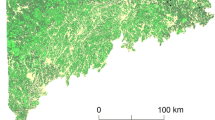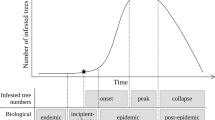Abstract
Context
Forest insect outbreaks are influenced by ecological processes operating at multiple spatial scales, including host-insect interactions within stands and across landscapes that are modified by regional-scale variations in climate. These drivers of outbreak dynamics are not well understood for the western spruce budworm, a defoliator that is native to forests of western North America.
Objectives
Our aim was to assess how processes across multiple spatial scales drive western spruce budworm outbreak dynamics. Our objective was to assess the relative importance and influence of a set of factors covering the stand, landscape, and regional scales for explaining spatiotemporal outbreak patterns in British Columbia, Canada.
Methods
We used generalized linear mixed effect models within a multi-model interference framework to relate annual budworm infestation mapped from Landsat time series (1996–2012) to sets of stand-, landscape-, and regional-scale factors derived from forest inventory data, GIS analyses, and climate models.
Results
Outbreak patterns were explained well by our model (R 2 = 93%). The most important predictors of infestation probability were the proximity to infestations in the previous year, landscape-scale host abundance, and dry autumn conditions. While stand characteristics were overall less important predictors, we did find infestations were more likely amongst pure Douglas-fir stands with low site indices and high crown closure.
Conclusions
Our findings add to growing empirical evidence that insect outbreak dynamics are driven by multi-scaled processes. Forest management planning to mitigate the impacts of budworm outbreaks should thus consider landscape- and regional-scale factors in addition to stand-scale factors.





Similar content being viewed by others
References
Alfaro RI, Sickle GAV, Thomson AJ, Wegwitz E (1982) Tree mortality and radial growth losses caused by the western spruce budworm in a Douglas-fir stand in British Columbia. Can J For Res 12:780–787
Alfaro RI, Taylor S, Brown RG, Clowater JS (2001) Susceptibility of northern British Columbia forests to spruce budworm defoliation. For Ecol Manag 145:181–190
Alfaro RI, Thomson AJ, Sickle GAV (1985) Quantification of Douglas-fir growth losses caused by western spruce budworm defoliation using stem analysis. Can J For Res 15:5–9
Anderson DP, Sturtevant BR (2011) Pattern analysis of eastern spruce budworm Choristoneura fumiferana dispersal. Ecography 34:488–497
Bartoń K (2009) MuMIn: multi-model inference. R-Package. https://cran.r-project.org/web/packages/MuMIn/MuMIn.pdf. Accessed 11 Nov 2016
Bates D, Mächler M, Bolker B, Walker S (2015) Fitting linear mixed-effects models using lme4. J Stat Softw 67:1–48
Bolker BM, Brooks ME, Clark CJ, Geange SW, Poulsen JR, Stevens MH, White JS (2009) Generalized linear mixed models: a practical guide for ecology and evolution. Trends Ecology and Evolution 24:127–135
Bouchard M, Auger I (2013) Influence of environmental factors and spatio-temporal covariates during the initial development of a spruce budworm outbreak. Landscape Ecol 29:111–126
Brookes MH, Campbell RW, Colbert JJ, Mitchell RG, Stark RW (1987) Western Spruce Budworm. USDA Forest Service Technical Bulletin No. 1694. Washington, DC. http://digitalcommons.usu.edu/cgi/viewcontent.cgi?article=1318&context=barkbeetles. Accessed: 11 Nov 2016
Brookes MH, Colbert JJ, Mitchell RG, Stark RW (1985) Managing Trees and Stands Susceptible to Western Spruce Budworm. USDA Forest Service Technical Bulletin No. 1695. Washington, DC. https://naldc.nal.usda.gov/naldc/download.xhtml?id=CAT86871967&content=PDF/latest. Accessed: 11 Nov 2016
Burnham KP, Anderson DR, Huyvaert KP (2010) AIC model selection and multimodel inference in behavioral ecology: some background, observations, and comparisons. Behav Ecol Sociobiol 65:23–35
Campbell EM, MacLean DA, Bergeron Y (2008) The Severity of Budworm-Caused Growth Reductions in Balsam Fir/Spruce Stands Varies with the Hardwood Content of Surrounding Forest Landscapes. For Sci 54:195–205
Cappuccino N, Lavertu D, Bergeron Y, Régnière J (1998) Spruce budworm impact, abundance and parasitism rate in a patchy landscape. Oecologia 114:236–242
Carlson CE, Wulf NW (1989) Silvicultural strategies to reduce stand and forest susceptibility to the western spruce budworm. In: USDA Forest Service Agricultural handbook No. 676. Washington, DC. https://naldc.nal.usda.gov/download/CAT89916903/PDF. Accessed 11 Nov 2016
Daly C, Gibson WP, Taylor GH, Johnson GL, Pasteris P (2002) A knowledge-based approach to the statistical mapping of climate. Clim Res 22:99–113
Dymond CC, Neilson ET, Stinson G, Porter K, MacLean DA, Gray DR, Campagna M, Kurz WA (2010) Future Spruce Budworm Outbreak May Create a Carbon Source in Eastern Canadian Forests. Ecosystems 13:917–931
Flower A, Gavin DG, Heyerdahl EK, Parsons RA, Cohn GM (2014) Drought-triggered western spruce budworm outbreaks in the interior Pacific Northwest: a multi-century dendrochronological record. For Ecol Manag 324:16–27
Foster JR, Townsend PA, Mladenoff DJ (2013) Spatial dynamics of a gypsy moth defoliation outbreak and dependence on habitat characteristics. Landscape Ecol 28:1307–1320
Gray DR, MacKinnon WE (2006) Outbreak patterns of the spruce budworm and their impacts in Canada. For Chronicle 82:550–561
Grueber CE, Nakagawa S, Laws RJ, Jamieson IG (2011) Multimodel inference in ecology and evolution: challenges and solutions. J Evol Biol 24:699–711
Hadley KS, Veblen TT (1993) Stand response to western spruce budworm and Douglas-fir bark beetle outbreaks, Colorado Front Range. Can J For Res 23:479–491
Heppner D, Turner J (2006) Spruce weevil and western spruce budworm forest health stand establishment decision aids. J Ecosyst Manag 7:45–49
Hicke JA, Allen CD, Desai AR, Dietze MC, Hall RJ, Ted Hogg EH, Kashian DM, Moore D, Raffa KF, Sturrock RN, Vogelmann J (2012) Effects of biotic disturbances on forest carbon cycling in the United States and Canada. Glob Change Biol 18:7–34
Hope GD, Mitchell WR, Lloyd DA, Erickson WR, Harper WL, Wikeen BM (1991) Interior Douglas-fir Zone. In: Meidinger D, Pojar J (eds) Ecosystems of British Columbia. British Columbia Ministry of Forests. Victoria, British Columbia, Canada, pp 153–166
Kennedy RE, Andréfouët S, Cohen WB, Gómez C, Griffiths P, Hais M, Healey SP, Helmer EH, Hostert P, Lyons MB, Meigs GW, Pflugmacher D, Phinn SR, Powell SL, Scarth P, Sen S, Schroeder TA, Schneider A, Sonnenschein R, Vogelmann JE, Wulder MA, Zhu Z (2014) Bringing an ecological view of change to Landsat-based remote sensing. Front Ecol Environ 12:339–346
King G, Zeng L (2001) Logistic regression in rare events data. Polit Anal 9:137–163
Kurz WA, Stinson G, Rampley GJ, Dymond CC, Neilson ET (2008) Risk of natural disturbances makes future contribution of Canada’s forests to the global carbon cycle highly uncertain. Proc Natl Acad Sci USA 105:1551–1555
Leckie DG, Gillis MD (1995) Forest inventory in Canada with emphasis on map production. For Chronicle 71:74–88
Link WA, Barker RJ (2006) Model weights and the foundations of multimodel inference. Ecology 87:2626–2635
Long JN (2009) Emulating natural disturbance regimes as a basis for forest management: a North American view. For Ecol Manag 257:1868–1873
Maclauchlan LE, Brooks JE, Hodge JC (2006) Analysis of historic western spruce budworm defoliation in south central British Columbia. For Ecol Manag 226:351–356
MacLean DA (1980) Vulnerability of fir/spruce stands during uncontrolled spruce budworm outbreaks: a review and discussion. For Chronicle 56(213):221
MacLean DA, Erdle TA, MacKinnon WE, Porter KB, Beaton KP, Cormier G, Morehouse S, Budd M (2001) The Spruce Budworm Decision Support System: forest protection planning to sustain long-term wood supply. Can J For Res 31:1742–1757
Meigs GW, Kennedy RE, Gray AN, Gregory MJ (2015) Spatiotemporal dynamics of recent mountain pine beetle and western spruce budworm outbreaks across the Pacific Northwest Region, USA. For Ecol Manag 339:71–86
Mildrexler D, Yang Z, Cohen WB, Bell DM (2016) A forest vulnerability index based on drought and high temperatures. Remote Sens Environ 173:314–325
Millar CI, Stephenson NL, Stephens SL (2007) Climate change and forests of the future: managing in the face of uncertainty. Ecol Appl 17:2145–2151
Murdock TQ, Taylor SW, Flower A, Mehlenbacher A, Montenegro A, Zwiers FW, Alfaro R, Spittlehouse DL (2013) Pest outbreak distribution and forest management impacts in a changing climate in British Columbia. Environ Sci Policy 26:75–89
Nakagawa S, Schielzeth H, O’Hara RB (2013) A general and simple method for obtaining R2 from generalized linear mixed-effects models. Methods Ecol Evol 4:133–142
Nealis V (2008) Spruce budworms, Choristoneura Lederer (Lepidoptera: Tortricidae). In: Capinera J (ed) Encyclopedia of entomology. Springer, New York, pp 3524–3531
Nealis VG (2012) The phenological window for western spruce budworm: seasonal decline in resource quality. Agric For Entomol 14:340–347
Nealis VG, Noseworthy MK, Turnquist R, Waring VR (2009) Balancing risks of disturbance from mountain pine beetle and western spruce budworm. Can J For Res 39:839–848
Nealis VG, Régnière J (2009) Risk of dispersal in western spruce budworm. Agric For Entomol 11:213–223
Nealis VG, Regniere J (2014) An individual-based phenology model for western spruce budworm (Lepidoptera: Tortricidae). Can Entomol 146:306–320
R Core Team (2014) R: A Language and Environment for Statistical Computing. R Foundation for Statistical Computing. https://www.r-project.org/. Accessed 11 Nov 2016
Radeloff VC, Mladenoff DJ, Boyce MS (2000) The changing relation of landscape patterns and jack pine budworm populations during an outbreak. Oikos 90:417–430
Raffa KF, Aukema BH, Bentz BJ, Carroll AL, Hicke JA, Turner MG, Romme WH (2008) Cross-scale drivers of natural disturbances prone to anthropogenic amplification: the dynamics of bark beetle eruptions. BioScience 58:501
Robert L-E, Kneeshaw D, Sturtevant BR (2012) Effects of forest management legacies on spruce budworm (Choristoneura fumiferana) outbreaks. Can J For Res 42:463–475
Seidl R, Fernandes PM, Fonseca TF, Gillet F, Jönsson AM, Merganičová K, Netherer S, Arpaci A, Bontemps J-D, Bugmann H, González-Olabarria JR, Lasch P, Meredieu C, Moreira F, Schelhaas M-J, Mohren F (2011) Modelling natural disturbances in forest ecosystems: a review. Ecol Model 222:903–924
Seidl R, Muller J, Hothorn T, Bassler C, Heurich M, Kautz M (2015) Small beetle, large-scale drivers: how regional and landscape factors affect outbreaks of the European spruce bark beetle. J Appl Ecol 53:530–540
Senf C, Pflugmacher D, Wulder MA, Hostert P (2015) Characterizing spectral–temporal patterns of defoliator and bark beetle disturbances using Landsat time series. Remote Sens Environ 170:166–177
Senf C, Wulder MA, Campbell EM, Hostert P (2016) Using Landsat to assess the relationship between spatiotemporal patterns of western. Can J Remote Sens. doi: 10.1080/07038992.2016.1220828. Accessed 11 Nov 2016
Shepherd RF (1994) Management strategies for forest insect defoliators in British Columbia. For Ecol Manag 68:303–324
Simard M, Powell EN, Raffa KF, Turner MG (2012) What explains landscape patterns of tree mortality caused by bark beetle outbreaks in Greater Yellowstone? Glob Ecol Biogeogr 21:556–567
Sturtevant BR, Gustafson EJ, Li W, He HS (2004) Modeling biological disturbances in LANDIS: a module description and demonstration using spruce budworm. Ecol Model 180:153–174
Sturtevant B, Cooke B, Kneeshaw D, MacLean D (2015) Modeling insect disturbance across forested landscapes: insights from the spruce budworm. In: Perera AH, Sturtevant BR, Buse LJ (eds) Simulation modeling of forest landscape disturbances. Springer, New York, pp 93–134
Swetnam TW, Lynch AM (1993) Multicentury, regional-scale patterns of western spruce budworm outbreaks. Ecol Monogr 63:399–424
Townsend PA, Singh A, Foster JR, Rehberg NJ, Kingdon CC, Eshleman KN, Seagle SW (2012) A general Landsat model to predict canopy defoliation in broadleaf deciduous forests. Remote Sens Environ 119:255–265
Turner MG (2010) Disturbances and landscape dynamics in a changing world. Ecology 91:2833–2849
Turner MG, Gardner RH (2015) Landscape ecology in theory and practice. Springer, New York
Volney WJA, Fleming RA (2007) Spruce budworm (Choristoneura spp.) biotype reactions to forest and climate characteristics. Glob Chang Biol 13:1630–1643
Wang T, Hamann A, Spittlehouse DL, Murdock TQ (2012) ClimateWNA—high-resolution spatial climate data for western North America. J Appl Meteorol Climatol 51:16–29
Wulder MA, Hall RJ, Coops NC, Franklin SE (2004) High spatial resolution remotely sensed data for ecosystem characterization. BioScience 54:511–521
Wulder MA, Dymond CC, White JC, Leckie DG, Carroll AL (2006) Surveying mountain pine beetle damage of forests: a review of remote sensing opportunities. For Ecol Manag 221:27–41
Wulder MA, White JC, Grills D, Nelson T, Coops NC, Ebata T (2009) Aerial overview survey of the mountain pine beetle epidemic in British Columbia: communication of impacts. J Ecosyst Manag 10:45–58
Zeileis A (2006) Object-oriented computation of sandwich estimators. J Stat Softw 16:1–16
Acknowledgements
Cornelius Senf gratefully acknowledges financial support from the Elsa Neumann Scholarship of the Federal State of Berlin. The research presented here contributes to the Landsat Science Team (http://landsat.usgs.gov/Landsat_Science_Team_2012-2017.php).
Author information
Authors and Affiliations
Corresponding author
Rights and permissions
About this article
Cite this article
Senf, C., Campbell, E.M., Pflugmacher, D. et al. A multi-scale analysis of western spruce budworm outbreak dynamics. Landscape Ecol 32, 501–514 (2017). https://doi.org/10.1007/s10980-016-0460-0
Received:
Accepted:
Published:
Issue Date:
DOI: https://doi.org/10.1007/s10980-016-0460-0




